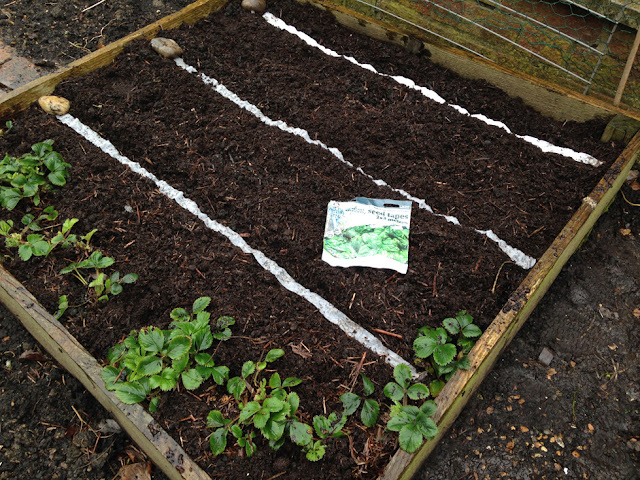I woke up to sunshine this Friday morning and, in an optimistic mood, headed down to the veg patch to do some sowing. Mr Fothergill's, a UK seed company, had sent me a selection from their new Get Growing and Optigrow ranges to trial this year including Nantes carrot seeds and seed tapes of Spinach 'Samish' - both can be direct sown in March so I thought "let's get on with it!"
Mr Fothergill's David Domoney Get Growing range is new for this year and has been created to encourage anyone who is new to growing veg from seed. That might sound odd to seasoned gardeners but I've met many people who don't know where to begin, which seeds to choose or what to do with them. With clear printed instructions on the packet for sowing, growing and harvesting, plus advice and a QR code which links to more tips from David Domoney, anyone can hope for success.
Sunshine turned to rain very quickly and four hours later I was back indoors, soaked through from the rain but feeling good from having had such a productive time in the garden. It was only after the rain started to come down quite heavily that I thought it best to call it a day.
First job of the day was, as usual, to remove any tiny weeds from the beds - it really is the only way to keep on top of the problem, little and often - and then my thoughts turned to topping up the raised beds. I have to do this every year, it's amazing how quickly the soil levels sink with all those worms munching and pooping away.
The plan today was to plant the spinach seed tapes, and intersperse with garlic (planted much too late but let's see what happens) and, in another bed, plant onion sets and intersperse those with rows of carrot seeds. In my experience, the onions mask the carrot scent and deter carrot root fly, a nasty pest that burrows into the young root to lay its eggs. Eeuww. Doesn't always work but has done for me. You can also put a 2ft/50cm high fine mesh barrier around the carrots as protection against these low flying beasties. I topped up the carrot/onion bed with ordinary multi-purpose compost. Not too rich, just enough nutrients for a month or so and deep enough for Nantes carrots which are a short early type.
I've not used seed tapes before so I was keen to get the spinach tapes planted! In this bed, I used a light mulch of Dalefoot's Double Strength Wool Compost to supplement last year's soil. Spinach likes soil to be nutrient dense and moist for a healthy crop and this particular compost from Dalefoot's comprehensive range will improve water retention as well as giving the soil a boost. The Strulch mulch from last year hadn't quite decomposed so I tickled the two mulches together before planting. No need to water as it had started to rain quite noticeably!
The seed tapes were a revelation! The last thing I wanted to do with wet hands was to try and trickle a row of spinach seeds into a drill. With the tapes, all I had to do was anchor one end of the tape, roll it out into the little trench I'd made and cover it over. Job done! So quick and the instructions were very clear on spacing, depth, timings and how to do it. The advice is to harvest every other plant to allow the remaining plants room to grow; or cut and come again up to four cuts for baby leaves.
I wondered whether it's the most economical way of growing spinach. The pack contained 6 metres of seeds across two 3 metre tapes; seeds are spaced roughly 1 inch apart on the tape, ie approximately 230 seeds for £2.99. This is slightly above the average cost but I imagine less seeds are wasted as they're pre-spaced for you. I planted three one metre rows today which should give me around 115 plants. That sounds a lot! Maybe two rows would have been enough. Germination should be in one to two weeks with first pickings in May so I'll plant another row of tape towards the end of April.
I have to say I love the ease and speed of the seed tapes - with everything else that needs to be done at this time of year, it gets one box ticked off the list very efficiently. Other seeds from the Get Growing range that I've been sent are parsnip seed tapes which I'm thrilled about as I've never been able to grow parsnips before, some cherry tomato seeds that are for growing in pots and seed mats for 5 varieties of herbs to grow year round indoors. As a very keen herb grower, I'm excited about the seed mats and will be trialling those in pots on the balcony.
All round, I feel this is a good range for newbie growers but let's see how the plants perform. I'll report back as and when but do give them a whirl if you're not sure where to start with veg growing ... even if you just have a windowsill or front door step; where the seeds can be grown - pots or direct sow outdoors - is clearly marked on the packet!
🌱😀🌿




